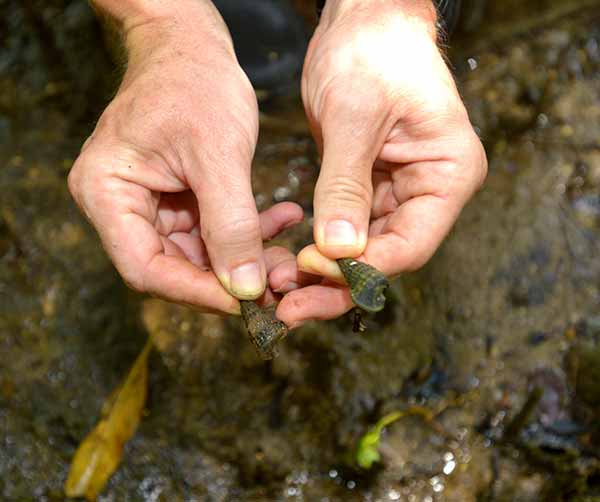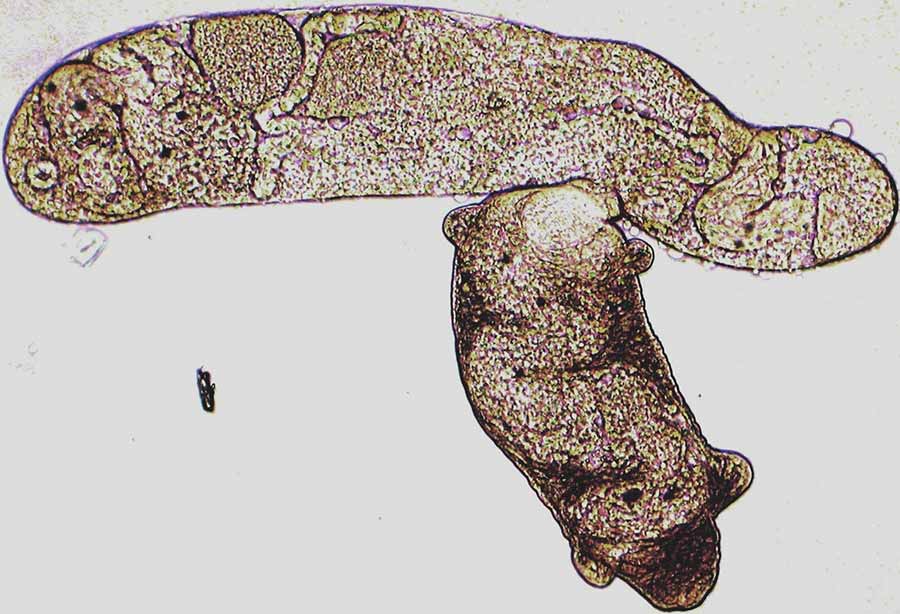Flatworms Flout Global Biodiversity Patterns
Scripps scientist co-leads discovery on parasite diversity
By:
- Beth King, Smithsonian Tropical Research Institute
Media Contact:
- Mario Aguilera - maguilera@ucsd.edu
- Robert Monroe - scrippsnews@ucsd.edu
Published Date
By:
- Beth King, Smithsonian Tropical Research Institute
Share This:
Article Content

Osamu Miura searches for marine horn snails in Bique, Panama. The snails are restricted to estuaries but widely distributed along the Pacific and Atlantic coasts. The scientists collected snails in five countries across 27 degrees of latitude, from Central America to the subtropical United States. Credit: Sean Mattson/STRI
The odds of being attacked and castrated by a variety of parasitic flatworms increases for marine horn snails the farther they are found from the tropics. Scientists at Scripps Institution of Oceanography at UC San Diego and the Smithsonian Tropical Research Institute (STRI) discovered this exception to an otherwise globally observed pattern—usually biodiversity is greatest in the tropics and decreases toward the poles. The study, published in Ecology, makes a case for using host–parasite relationships as a tool to understand why there are typically more species—and more intense interactions between species—in the tropics than anywhere else in the world.
“Once again, we see that we can use parasites to help understand basic mysteries of nature,” said Ryan Hechinger, a professor at Scripps Oceanography and one of the lead authors of the study.
Generations of scientists have tried to explain why biodiversity decreases from the tropics to the poles—a pattern known as the latitudinal diversity gradient. Suggested hypotheses include greater seasonal stability, more complex food webs, and faster rates of speciation (generation of new species) in the tropics relative to higher latitudes. Because many of these variables change together at the same time, it is hard to test the effects of one factor independent of the other variables.

The Pacific horn snail and Atlantic horn snail are two closely related species found in estuaries along the coasts from the tropics to the temperate zone. Since they are broadly distributed across varying habitats, and host several species of parasitic flatworms under their shells, these snails provide scientists with an ideal opportunity to study questions about how diversity changes with latitude. Credit: Sean Mattson/STRI
“The cool thing about horn snails and their parasites is that we can actually test hypotheses about biodiversity,” said Mark Torchin, a staff scientist at STRI who co-led the study. He explains that even across a widely variable geographic range—along the Pacific and Atlantic coasts from Central America to the subtropical United States—horn snails serve as natural, standardized habitats for measuring parasite diversity. “It lets us do a real, apples-to-apples comparison because the habitat—the snails—is the same across this broad geographic region.”
The Pacific horn snail (Cerithideopsis californica) and Atlantic horn snail (C. pliculosa) are two closely related species widespread in estuaries along the coasts from the tropics to the temperate zone. At least 20 species of trematode—a kind of flatworm—compete to parasitize and castrate the snails. The trematodes produce offspring that leave the snails and eventually infect migratory sea birds. Although the snails are restricted to their local habitat, the trematodes themselves are spread across vast distances by birds.
Hechinger explains that the parasites’ unusual life history allowed the research team to simplify the question of how the latitudinal diversity gradient arose. For instance, because the trematodes spread so quickly up and down the coast, they could rule out speciation rates as a factor affecting their pattern of distribution.

A trematode worm bites and sucks out the insides of an enemy species, with the eyespots of the victim’s offspring still visible inside the attacker’s gut. At least 20 species of trematode compete to parasitize and castrate marine horn snails. Such predatory interactions are more frequent in the temperate zone than the tropics. Credit: Ryan Hechinger, Scripps Institution of Oceanography, UC San Diego.
“So, if higher speciation rates in the tropics cause the normal diversity gradient, and we stop that from being a factor—like with these parasites—we shouldn’t see the usual pattern,” Hechinger said. “That’s exactly what happened in our study, suggesting that speciation does play a role in creating the normal latitudinal diversity gradient.”
The research team collected snails and parasites from 43 field sites spread across five countries and 27 degrees of latitude in the Pacific and Atlantic Oceans, and found that parasite prevalence, diversity, and competition rates all increased at higher latitudes in a reversed diversity gradient. The reversed pattern suggests that local ecological factors also have a part to play in shaping biodiversity. In the tropics, environmental instability—such as from hurricanes or storm runoff—and greater snail death rates might decrease the available pool of snails for trematodes to parasitize. Conversely, greater stability and larger snail populations in the temperate zone sustain higher trematode species diversity over time.
The scientists also found that the parasites kill each other more frequently at higher latitudes.
“When two of these parasites find themselves in the same host snail, one kills the other,” said Hechinger. “And this is happening a lot more in the north than in the south.”
This finding is also contrary to general patterns, where people expect interactions to be more intense in the tropics.
The scientists note that there are other advantages to paying attention to parasites, which are generally overlooked despite being very numerous and diverse.
“Parasites are a huge chunk of all species,” said Hechinger. “How can we possibly understand the shape of the ‘normal’ pattern if we don’t pay attention to perhaps the largest part of biodiversity?”
However, apart from their study and some research on humans, the authors are aware of no other comprehensive studies looking at how parasite diversity changes in a single, wide-ranging species across latitude.
The researchers are expanding their work on parasite diversity. “We now have a plan to conduct similar research in Asia to test the robustness of our findings on the other side of the world,” said co-author Osamu Miura, former postdoc at STRI and now associate professor at Kochi University in Japan. “The prospects are exciting!”
Share This:
You May Also Like
UC San Diego is Strengthening U.S. Semiconductor Innovation and Workforce Development
Technology & EngineeringStay in the Know
Keep up with all the latest from UC San Diego. Subscribe to the newsletter today.



